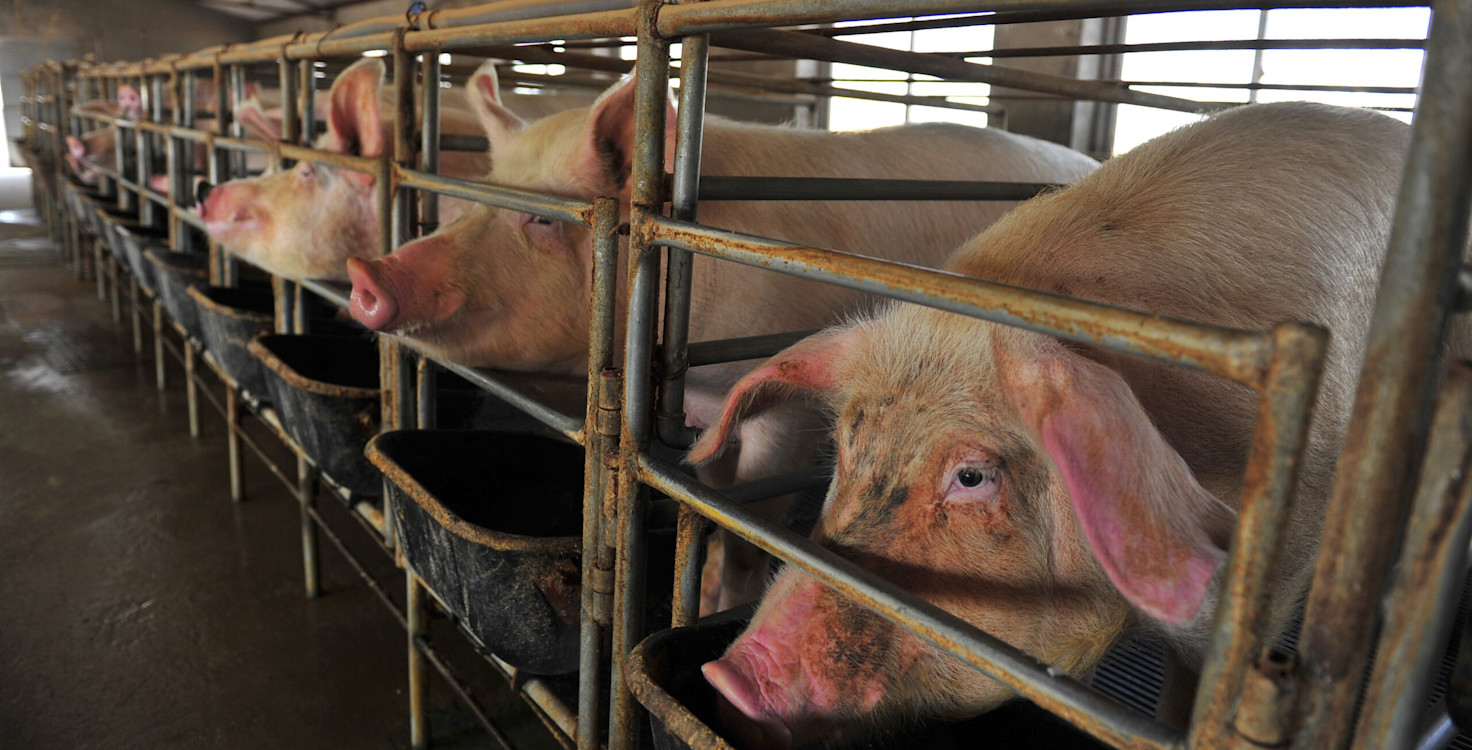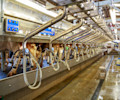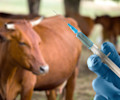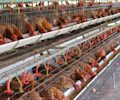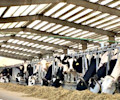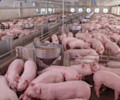Gestation crates are widely used but have adverse health and welfare implications
A gestation crate, also known as a sow stall, is a metal enclosure in which a farmed sow used for breeding might be kept during pregnancy. The welfare impacts from the use of these crates in factory farming are highly controversial primarily due to their small size, often just 2m x 60 cm, barely larger than the sow’s body and therefore preventing the sow from moving and turning around. Gestation crates have been linked to increases in abnormal sow behaviour, including sham chewing and bar-biting, which is indicative of stress and frustration. Additionally, the United States Department of Agriculture has stated that gestation crates have negative repercussions for a sow’s cardiac function, bone strength and posture.
Despite this, pork producers, primarily in the US and Asia, continue to use gestation crates as they allow for maximum numbers of animals to be housed in a single barn and reduce labour requirements due to automated feed and water systems. In addition to cost savings, pork producers argue that gestation crates prevent injury and mortality that can arise from the sows being aggressive towards each other.
The rise in consumer and investor activism makes the practice a liability for food companies
Pork producers and retailers are facing increasing scrutiny from the public and activists on the use of gestation crates. A 2008 US national survey found that 69% of respondents would vote for a referendum prohibiting the use of gestation crates in their state of residence. The same survey also found that respondent demographics and the level of pork production in the state had no significant impact on participants’ responses, suggesting that a wide range of consumers are prioritising the welfare argument over economics. A 2020 survey by World Animal Protection and Crate Free Illinois found that regular pork buyers would be willing to pay more for brands that commit to eliminating gestation crates. While consumer commitments to pay price premiums are difficult to measure in practice, 2021 data from SPINS shows that sales of products with animal welfare claims have increased by 27% since 2019, evidencing the growing consumer interest in this area.
69%
of respondents would vote to ban the use of gestation crates in their state
71%
of respondents would pay higher premiums for crate-free pork
Growing consumer awareness has been driven by an ever-growing number of campaigns and petitions against gestation crates, which has led to over 200 companies committing to phase them out. Furthermore, consumers have used their voting power through ballot measures to limit the practice; for example, California’s Proposition 12 was supported by 63% of voters.
Grassroots organisations have not been acting alone; shareholders and investor activists are also putting pressure on companies and suppliers that continue to use these production practices. A 2016 shareholder resolution asked Tyson Foods to disclose the potential risks and operational impacts of gestation crates in its supply chain, including those relating to animal cruelty, brand reputation, public perception and regulatory compliance, within six months of the AGM.
Investor activists are also engaging on this topic, with billionaire investor, Carl Icahn, recently calling out McDonald’s for allowing their suppliers to use gestation crates despite claiming in 2012 to be phasing them out over a 10-year period. The activist, who owns just 200 shares, has nominated two directors, Leslie Samuelrich and Maise Ganzler, to the board. At McDonald’s annual general meeting this spring, its shareholders will vote on these nominees unless a settlement is agreed on beforehand. The media coverage from prominent newspapers, including The Wall Street Journal, has forced McDonald’s to respond to this public challenge over the use of gestation crates and poses a risk to McDonald’s brand and reputation.
Gestation crates are increasingly being phased out by regulation
In many Western countries, changing consumer attitudes on gestation crates have limited their use. Sweden was the first country in 1994 to introduce a ban on gestation crates, shortly followed by the UK in 1999. In 2010, New Zealand committed to phasing out their use by 2015, and in 2013, the European Union agreed to prohibit their use.
The US, which is the third-largest pork producer globally, is an outlier here as there is no federal ban on gestation crate use. However, around ten states have chosen to introduce their own bans on pork production using crates, starting as early as 2002 in Florida (see Appendix). Most of the states that have introduced these bans produce relatively small quantities of pork, and therefore, there has been no significant impact on pork producers so far.
However, this is changing. The 2016 Massachusetts regulation and the 2018 Californian regulation (Proposition 12) go beyond banning gestation crates for in-state production and instead ban the in-state sale of pork reared from gestation crates. These changes in legislation are expected to cause significant financial risks for companies that currently rely on this method of pork production as it prevents them from accessing these markets; for example, California consumes around 14% of the country’s pork. The EU has taken cage-free legislation even further, having recently voted to ‘End the Cage’. This European Citizens’ Initiative will not only ban EU producers from using gestation crates, but it will also apply to pork imported to Europe, potentially resulting in financial risks reaching beyond the countries adopting crate-free legislation.
California’s Proposition 12
FARM ANIMAL
CURRENT LAW
PROPOSITION 12
Egg-laying hens
Must be able to turn around freely, lie down, stand up, and extend their limbs fully
Cage-free housing
Breeding Pigs
24 square feet of floor space
Calves raised for veal
43 square feet of floor space
Proposition 12 establishes new standards for the confinement of egg-laying hens, breeding pigs and calves raised for veal. It also bans the sale of products that do not meet new housing standards.
It is illegal for businesses in California to sell eggs and uncooked pork or veal that comes from animals not raised in these new housing standards
The ban applies to products produced in California and imported into California
Cooked pork and pork mixed with other ingredients is not covered by this ban
Pork producers that do not plan for regulatory changes will see higher production costs
There is an ongoing debate as to whether or not production costs are higher when producing crate-free pork. A report for the European Commission found that for each 0.5m2 increase in space per sow, there is an approximate 1% increase in investment and housing costs. In contrast, an economic comparison in Canada found that costs for construction of group housing that allowed for more space per sow were 4% cheaper than conventional gestation crate housing.
Irrespective of this debate, it is clear from the backlash from California’s Proposition 12 legislation that if pork producers are unprepared for the changes brought about through legislation and activism, they are likely to incur high financial costs. The three options for achieving Proposition 12’s requirements vary in costs:
Reduce herd size: the most straightforward option is to reduce the number of sows within each housing unit, with some producers being required to reduce their herd by up to 25%. This is predicted to increase the production costs by up to $17 per piglet.
Modify crates: the second option is to modify their current gestation crates to meet the new requirements, which is estimated to increase the costs by $4.7 per piglet over the 25 year lifetime of the equipment.
Build new housing: The third option is to build new housing that abides by the Proposition 12 regulation; however, this is the most expensive option at $3,000 to $4,000 per sow.
Regardless of how they transition to new methods of sow housing, companies must adequately prepare to mitigate increasing production costs. As gestation crates typically last for 25 years, they could become stranded assets before the end of their lifetime. Pork producers should, therefore, look into the risk of asset stranding while investing in alternative housing within existing units. This, of course, should happen in advance of regulatory changes that could affect production. For example, UK egg producers in 2011 had to remove “enriched cages”, installed only a few years earlier at a cost of £400 million, due to the market for cage-free eggs collapsing.
In terms of consumer costs, a study by the University of California found that Proposition 12-compliant pork will rise by 3.7%, meaning that the average price of uncooked cuts of pork will increase by 7.7% in California. However, companies like Whole Foods are acting early on this issue and estimate that their customers will not experience a price increase as their suppliers are already compliant.
The rapid cage-free transition illustrates the risk for the pork industry
Regulatory pressure combined with consumer and investor activism has already resulted in significant changes in the food market; for example, eggs marketed as cage-free in the US made up just 2% of the market in 2010. By 2020, they accounted for 28% of the market and are expected to reach 70% by 2026. This rapid change in demand poses a significant risk to companies that continue to produce and sell caged eggs, and the industry has had to respond. America’s largest egg company, Cal-Maine Foods, has invested more than $500 million since 2008 to expand the company’s cage-free egg production capacity. Similarly, pork producers using gestation crates need to be aware of the reputational, regulatory and financial risk associated with this method of production and mitigate these risks by investing in sow housing that meets minimum requirements.
Appendix:
Please find a list of current regulations below. This is accurate as of February 2022.
1994: Sweden bans gestation crates.
1999: The UK bans gestation crates.
2002: Florida bans gestation crates; producers have six years to phase them out.
2006: Arizona bans gestation crates; producers have six years to phase them out.
2007: Oregon bans gestation crates; producers have five years to phase them out.
2008: California bans gestation crates; producers have seven years to phase them out.
2008: Colorado bans gestation crates; producers have ten years to phase them out.
2009: Maine bans gestation crates; producers have two years to phase them out.
2009: Michigan bans gestation crates; producers have 16 years to phase them out.
2010: Ohio bans gestation crates; producers have 16 years to phase them out.
2010: New Zealand bans gestation crates; producers have five years to phase them out.
2012: Rhode Island bans gestation crates; producers have one year to phase them out.
2013: European Union restricts the use of gestation crates to the first four weeks of a sow’s pregnancy and the week before giving birth.
2016: Massachusetts bans the use of gestation crates by 2022. It also bans the sale of any animal products raised in extreme confinement conditions from any other state.
2018: California’s Proposition 12 bans the sale of pork from pigs kept in gestation crates. The Supreme Court upheld Proposition 12 when efforts by the meat industry attempted to have the ban overturned. The ban came into effect for pork producers at the beginning of 2022; however, it has been temporarily delayed for retailers, thus allowing imported pork from pigs reared in gestation crates to continue being sold in California.
